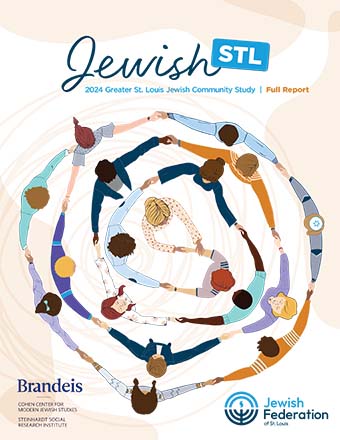2024 Greater St. Louis Jewish Community Study
 Matthew A. Brookner, Janet Krasner Aronson, Matthew Boxer, Alicia Chandler, Leonard Saxe, Evan Herring-Nathan, David Dutwin with Ilana Friedman, Vivian Jacobs, Daniella Levine, Raquel Magidin de Kramer, Adam Martin, and Danny Nussbaum
Matthew A. Brookner, Janet Krasner Aronson, Matthew Boxer, Alicia Chandler, Leonard Saxe, Evan Herring-Nathan, David Dutwin with Ilana Friedman, Vivian Jacobs, Daniella Levine, Raquel Magidin de Kramer, Adam Martin, and Danny Nussbaum
March 2025
The 2024 Greater St. Louis Jewish Community Study creates a portrait of the characteristics, attitudes, and behaviors of the Jewish community in Greater St. Louis. The study is based on an analysis of data collected from 1,771 eligible households between January and April 2024. We found the community is undergoing both reurbanization and exurbanization, with more than one third of households living in the City of St. Louis or outlying areas, farther away from the longstanding suburban center of institutional life.
Among the Key Findings:
- Greater St. Louis includes 45,800 Jewish adults and children living in 26,700 households; these households also include 12,600 adults and 2,800 children who are not Jewish.
- About one quarter of Jewish households (24%) reside in the Creve Coeur area, and 22% live in St. Louis City. Eighteen percent of Jewish households reside in U. City / Clayton, 12% are in Chesterfield / West County, and 11% are in Olivette / Ladue. The remaining 13% of Jewish households reside in the rest of Greater St. Louis.
- About half of Jewish adults (52%) were raised in Greater St. Louis. This share includes 30% who have lived in the area for their entire adult lives, and 22% who moved away and returned
- Fifty-seven percent of Jewish households have an adult child or a parent living in another household within Greater St. Louis.
- Of the 12,800 children in Jewish households, 10,000 (78% of all children) are considered Jewish by their parents. More than half of all children are considered Jewish exclusively (7,600 or 59% of all children). Nineteen percent of all children are considered Jewish and another religion.
- Half of Jewish students in grades K-12 during the 2023-24 school year and summer 2023 were enrolled in some form of Jewish education, including schools, other year-round programs, and camps.
- Thirty-six percent of Jewish households belong to some type of Jewish congregation located in Greater St. Louis, including synagogues, an independent minyan or chavurah, Chabad, and other worship communities.
- One quarter of all Jewish households (24%) belong to a Reform synagogue or temple, which is equivalent to 66% of all congregation-member households.
Forty-one percent of Jewish adults who do not belong to a congregation attended a Jewish religious service at least once. - Almost half of Jewish adults who have moved to Greater St. Louis in the past five years (48%) cite not knowing many people as a barrier to their participation in Jewish programs, compared to 31% of all Jewish adults.
- Forty-four percent of Jewish adults feel part of a community in Greater St. Louis through a Jewish organization or group, such as a synagogue or minyan, The J, or a chavurah. Within this group, the Jewish organization or group is the primary or only local community for 13% of Jewish adults and is a secondary community for 32%.
- More than two thirds of Jewish adults feel some level of emotional attachment to Israel, with 35% feeling somewhat attached and 38% feeling very attached. Taken together, the proportion who are somewhat or very attached to Israel (73%) is a larger share than is found among all US Jewish adults (58%).
- More than half of Jewish adults in Greater St. Louis have been to Israel, including 24% who have visited once, 25% who have visited more than once, and 6% who have lived in Israel.
- About half of Jewish adults (51%) avoid activities out of a fear of antisemitism. Thirty-six percent avoid mentioning Israel either in person or online, and 26% say they avoid posting Jewish content online that would identify them as a Jew. Twenty-eight percent say they avoid wearing or displaying objects that would identify them as a Jew, and 24% say they avoid going to certain places or events.
- One percent of Greater St. Louis Jewish households report they cannot make ends meet, and another 17% indicate they are just managing to make ends meet. More than one third of households (36%) have enough money, one quarter (25%) have extra money, and one fifth (20%) describe themselves as well-off.
- Eleven percent of Jewish households in Greater St. Louis were unable to pay for at least one necessity within the past year, and another 5% were unable to pay for at least one necessity between one to three years ago.
- Nearly one quarter (23%) of younger adults ages 22-39 report having fair or poor mental health, compared to 11% of all Jewish adults in Greater St. Louis.
- Twenty-six percent of Jewish households include a member with a chronic health issue, disability, or other need that affects their participation in work, school, or other activities.